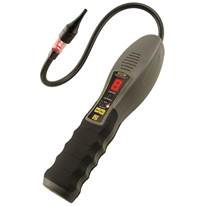 The Digital Refrigerant Leak Detector (RLD400) from General Tools & Instruments has been certified by an accredited independent test laboratory to comply with the new American Society of Heating, Refrigerating and Air-Conditioning Engineers (ASHRAE) Halocarbon Refrigerant Leak Detector Standard 173-2012. The instrument has been certified at a leak rate of less than 1 gram per year.
The Digital Refrigerant Leak Detector (RLD400) from General Tools & Instruments has been certified by an accredited independent test laboratory to comply with the new American Society of Heating, Refrigerating and Air-Conditioning Engineers (ASHRAE) Halocarbon Refrigerant Leak Detector Standard 173-2012. The instrument has been certified at a leak rate of less than 1 gram per year.
The new standard was published in December 2012 by ASHRAE to establish a method of testing for qualifying the performance of portable leak detectors designed for the detection of all CFC, HCFC, HFC, HFO and PFC halogenated refrigerant gases. The practices and procedures in this standard cover the testing of refrigerant leak detectors intended for use in the leak testing of refrigerating, air-conditioning and heat-pump systems and their components.
General’s RLD400 is also certified to comply with SAE J2791, J2913 and J1627 standards, and the new European standard EN14624:2012. According to the company, it is the only instrument of its kind to meet all five standards.
The RLD400 offers advanced detecting power and affordability. With its proprietary semiconductor sensor, this instrument is built to detect all commercially available HFC, HFO, HC, HCFC and CFC refrigerant gases, including many new ozone layer-friendly blends, such as R-22 and R-1234yf, approved under the EPA’s Significant New Alternatives Policy (SNAP).
This Made in America instrument is ideal for inspecting and maintaining mobile and stationary air conditioners, refrigerators, chillers and heat pumps, as well as automotive and aviation A/C systems. The RLD400 effectively pinpoints leaks, providing these benefits:
• Prevents compressor, evaporator and condenser damage caused by air and moisture entering a system;
• Saves money by precluding repeated system recharges and inefficient cooling operation;
• Helps large system operators meet U.S. Clean Air Act leak repair timetable standards; and
• Inhibits further depletion of the ozone layer.
Among the RLD400’s best-in-class features are the lifespan of its proprietary semiconductor sensor — more than 300 hours of operation or 10 years normal use — and sensitivities of 0.05 oz./year (1.4 g/year) to R-134a and 0.025 oz./year (0.7 g/year) to R-22. A true mechanical pump draws in samples, which increases sensitivity. Three sensitivity levels let users choose the right level for specific environments. Triple-redundant leak indication — a loud, fast beep; a bright flashing LED; and a relative digital leak size readout — make it easy to identify and characterize leaks in any setting. The RLD400’s automatic calibration and reset ensures accurate leak readings not distorted by ambient levels. In addition, a leak test vial containing a refrigerant sample allows users to easily confirm the instrument is operating correctly. And with its durable construction and padded hard plastic carrying case, the RLD400 is built to survive punishing tasks and harsh environments.
To learn more about General Tools & Instruments and its products, visit www.generaltools.com or call customer support at 1-800-697-8665.
AACF Celebrates 65 Years Serving the Aftermarket
AACF will be announcing more details about this commemorative fundraiser April 1st.
The Automotive Aftermarket Charitable Foundation (AACF), a 501c3 supporting people in the automotive aftermarket industry and their families during the hardest moments of their lives, said it is "thrilled to recognize 2024 as the year the organization celebrates its 65th anniversary, a testament to decades of heartfelt assistance to families within the automotive aftermarket sector." Originally established in 1959 as AFFTA, AACF owes its inception to the visionary spirit of Don Schlenger, a beloved figure in the automotive aftermarket industry.
Tech Tip: No Start in Cold Weather Due to No Weep Hole
This condition can be caused by condensation freezing in the muffler assembly.

Determining Catalytic Converter Efficiency
Almost every part on the engine determines how long a catalytic converter will last.

Talking To Customers About Oxygen Sensors
One of the toughest components to sell as a maintenance item, or even a replacement item, is an oxygen sensor.

PCV System DTC
PCV systems are far more complex now, but they are also much better at controlling crankcase pressure.

Other Posts
Bendix Releases Technical Materials for ADAS Support
They are designed to help technicians properly set up, inspect, and diagnose several components integrated with ADAS.

Dayco Adds Almost 30 Part Numbers in March
The 29 new part numbers will be available by the end of March for distributors interested in adding to their product coverage.
ASE Designates June as Automotive Service Professionals Month
ASE urges industry members to embrace Automotive Service Professionals Month as a platform for expressing gratitude.
ZF Aftermarket Releases 80 New Parts
The latest additions expand coverage to more than 5 million vehicles in operation.

